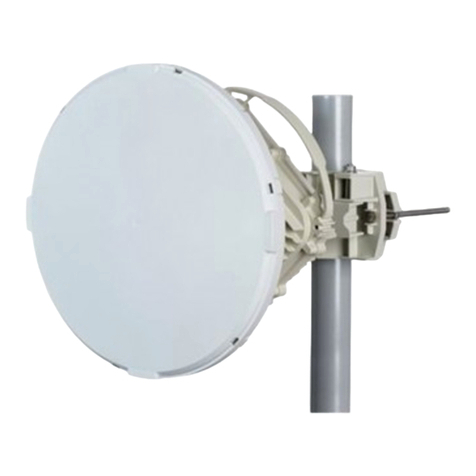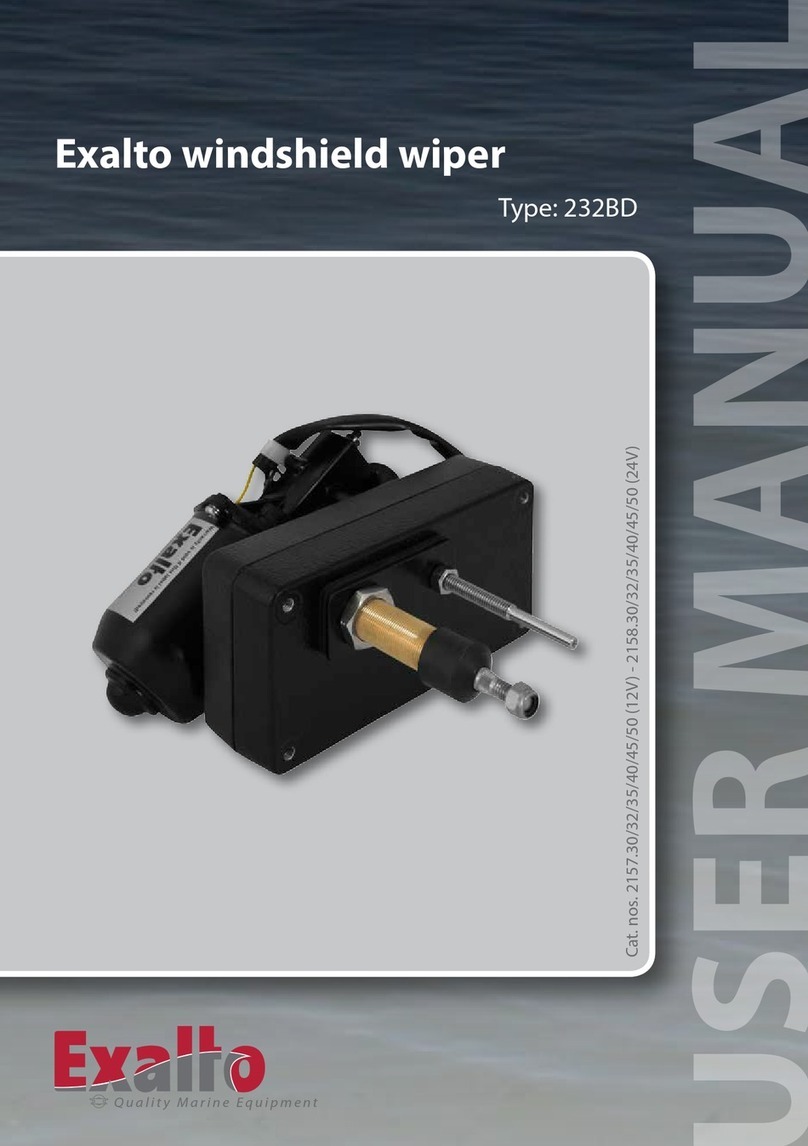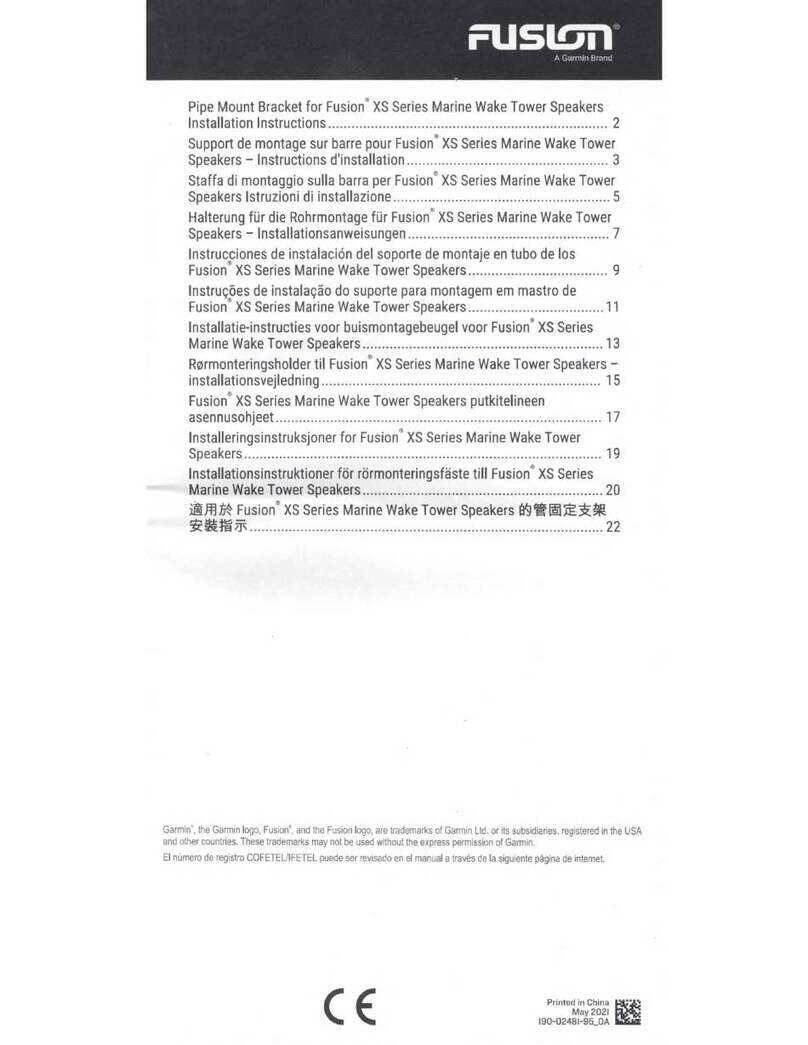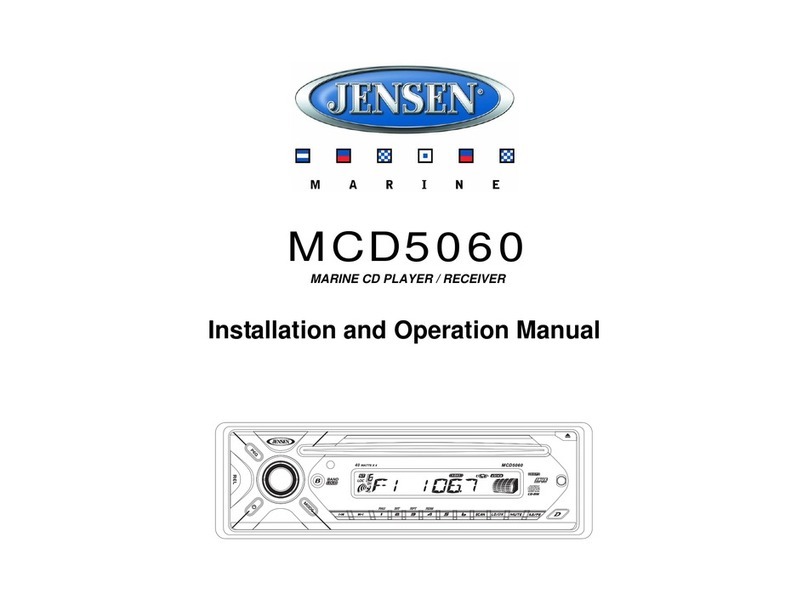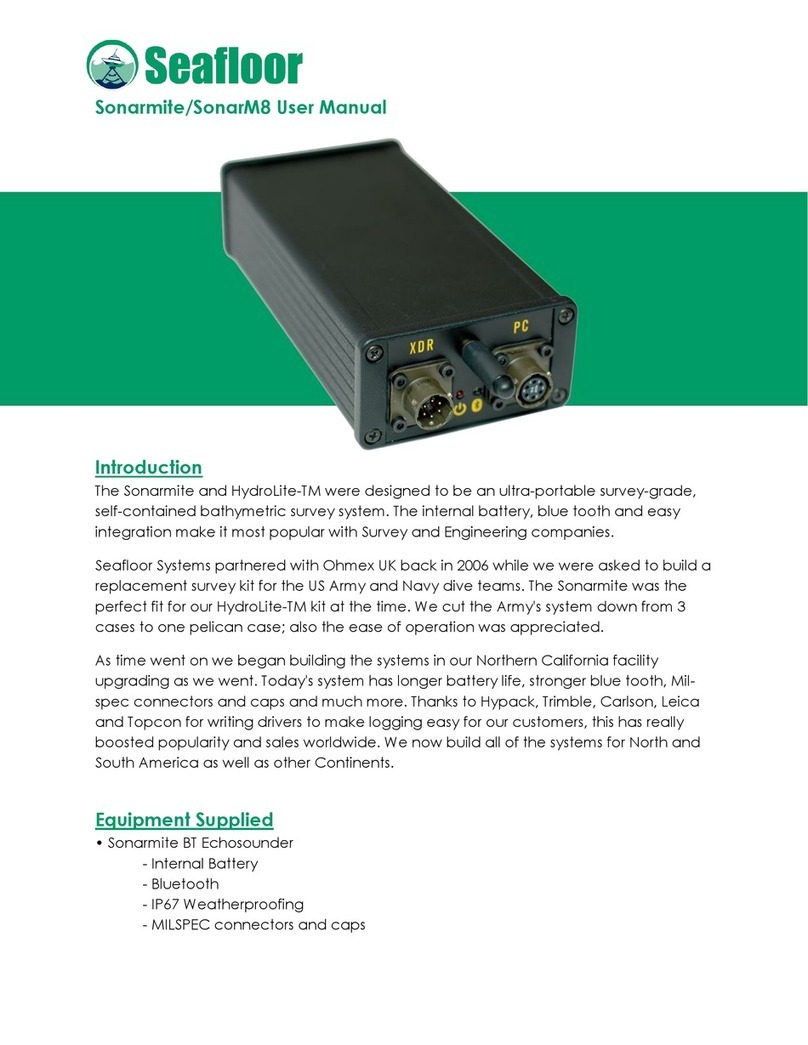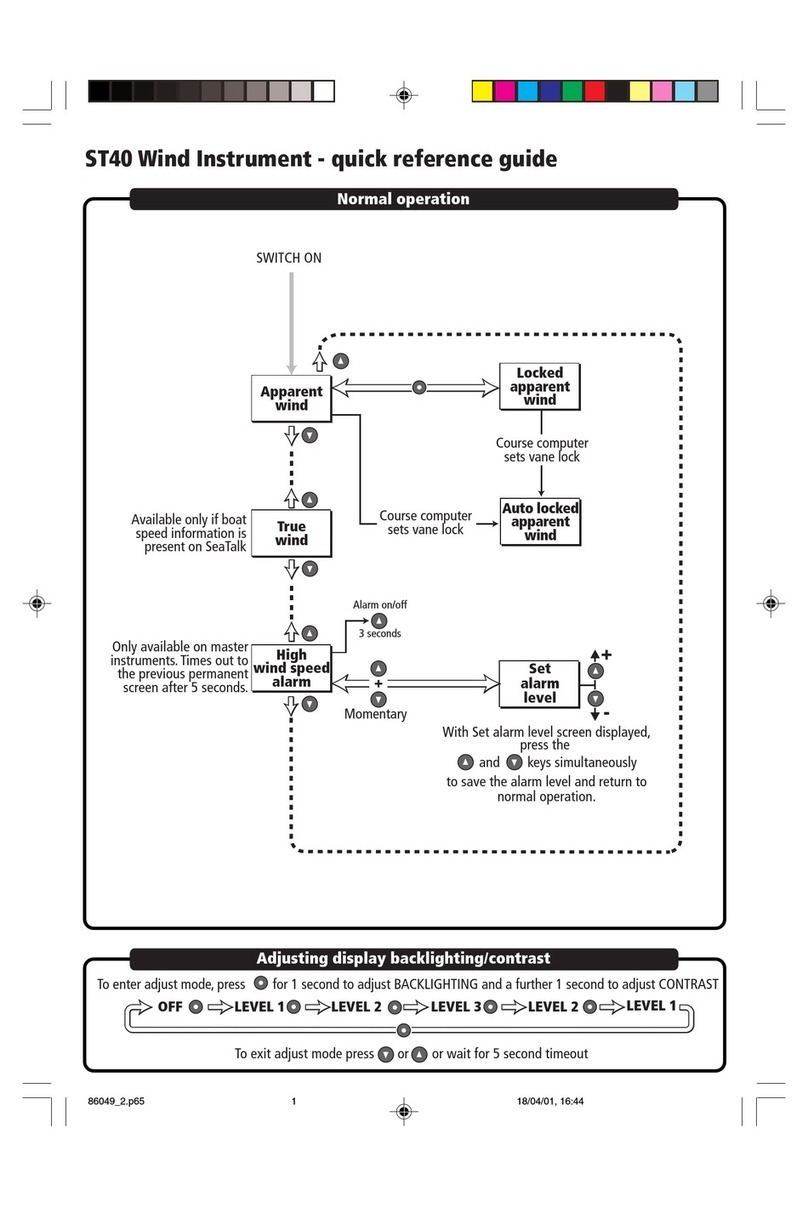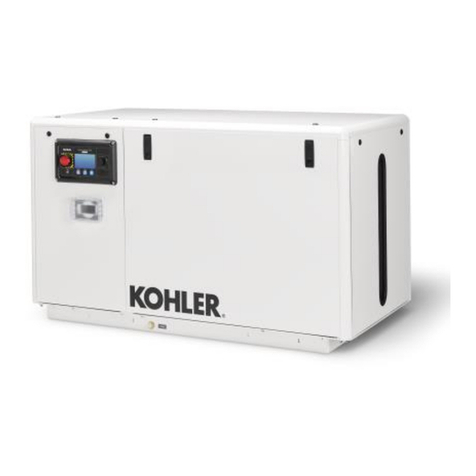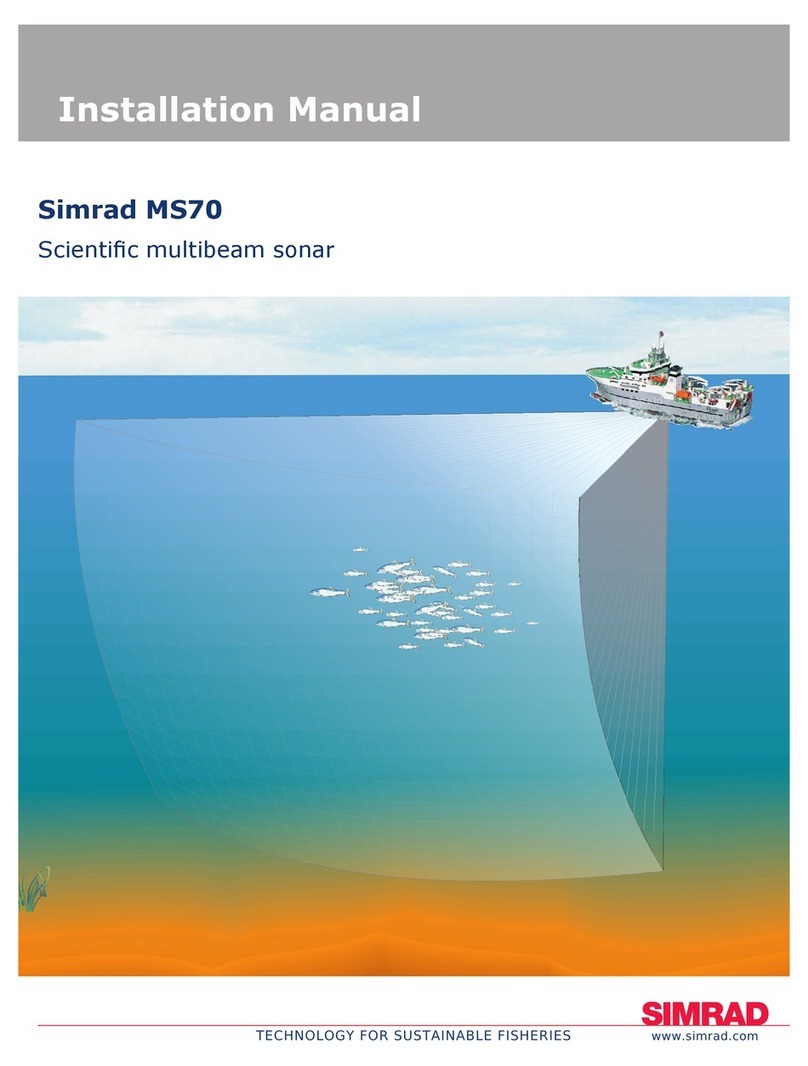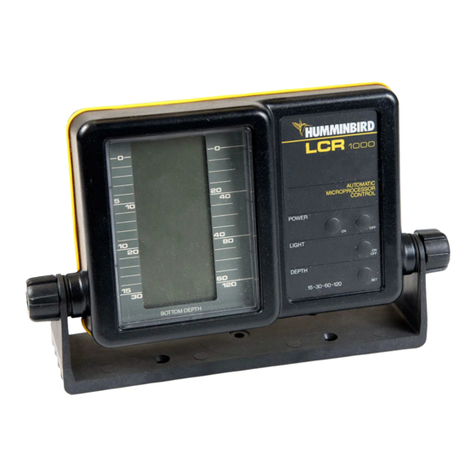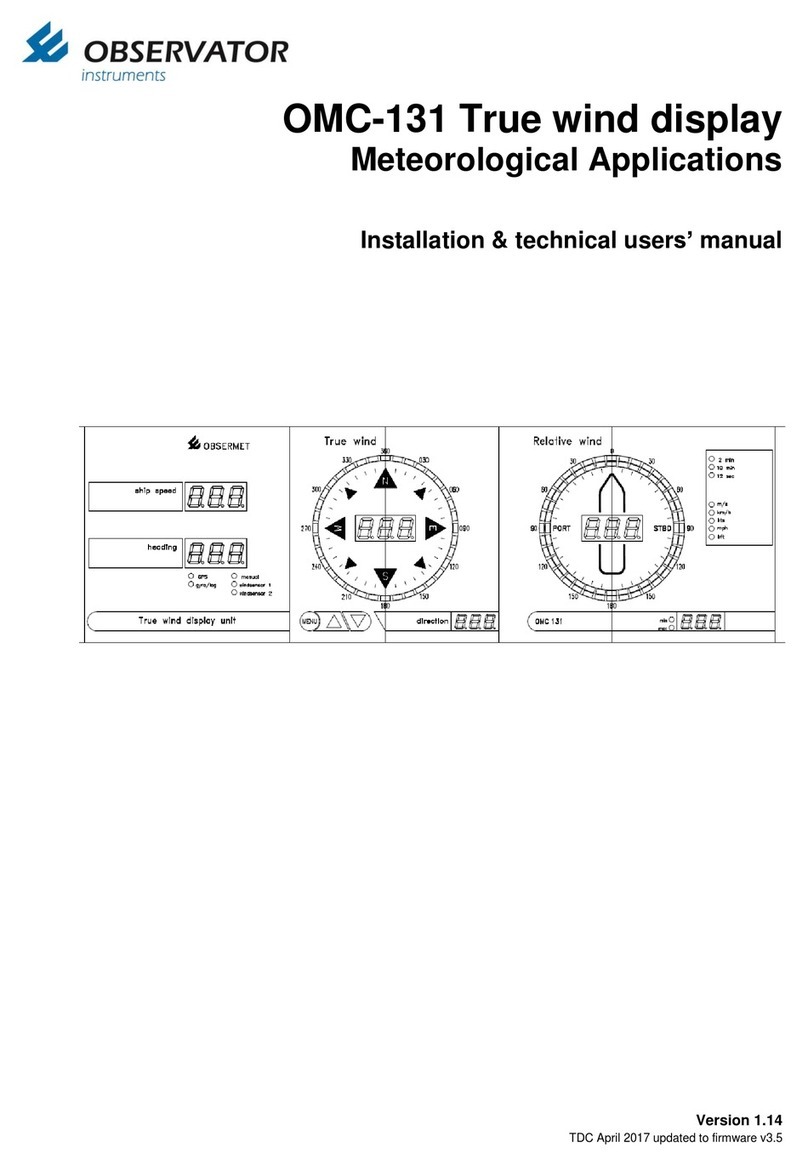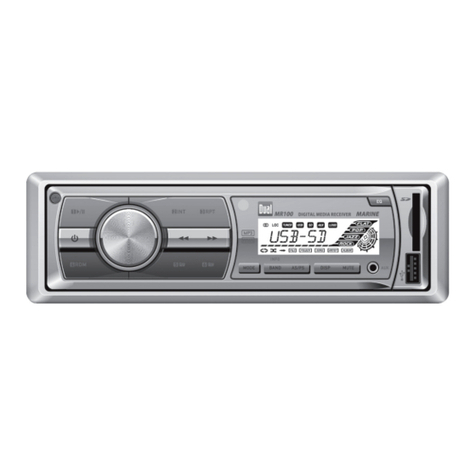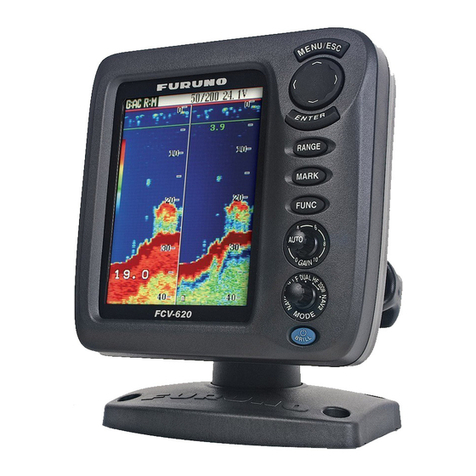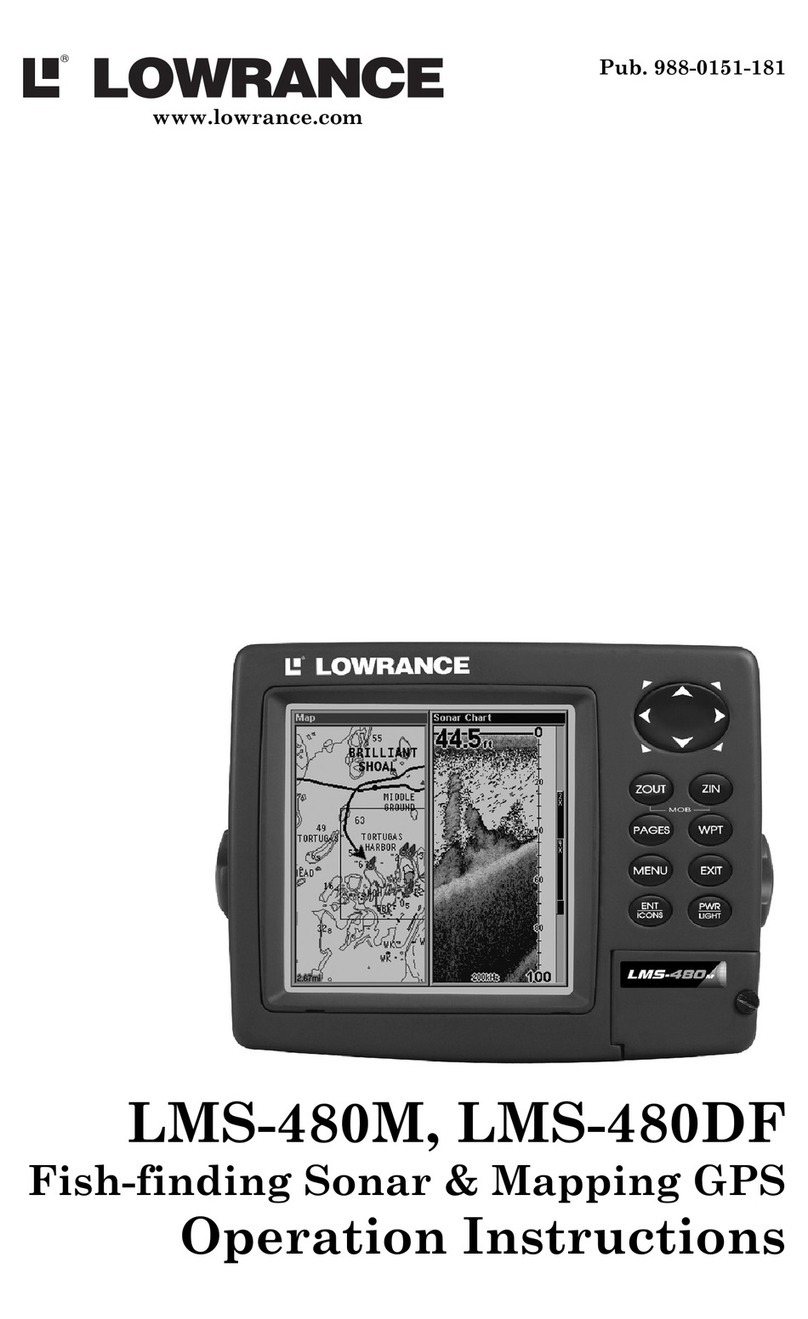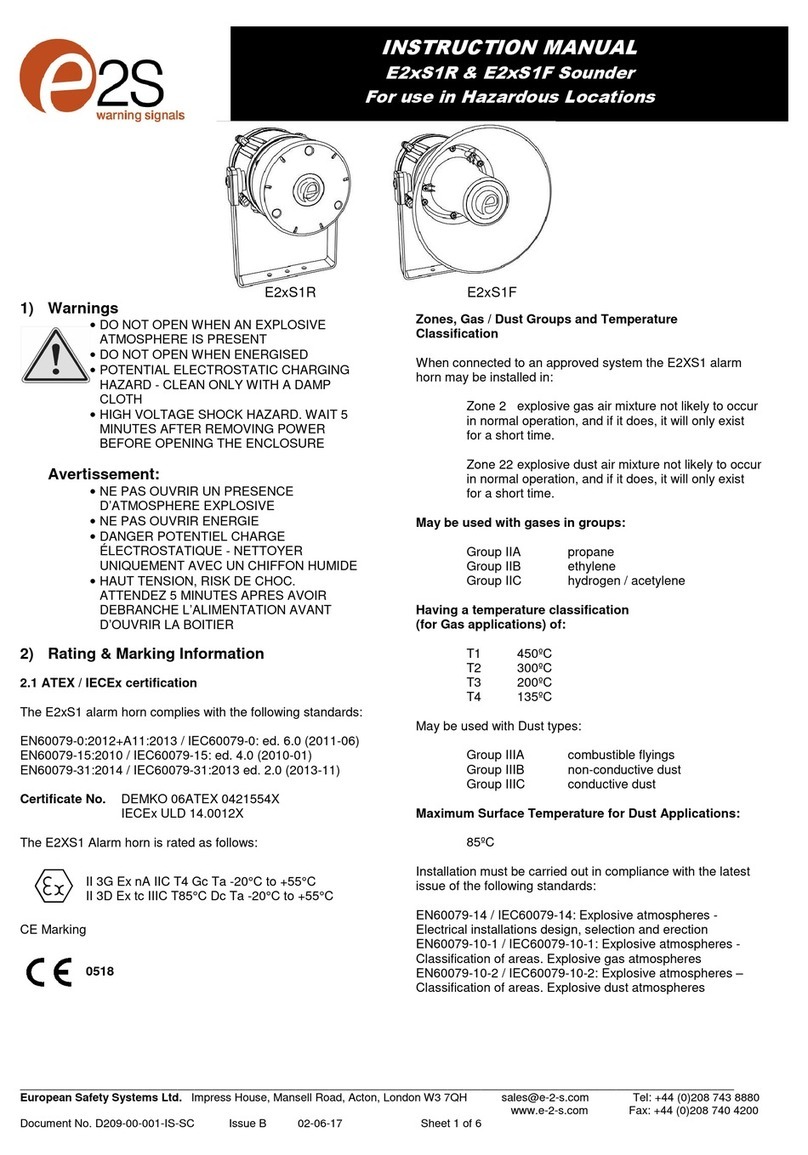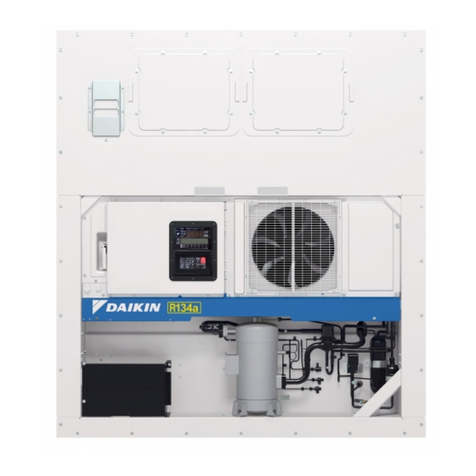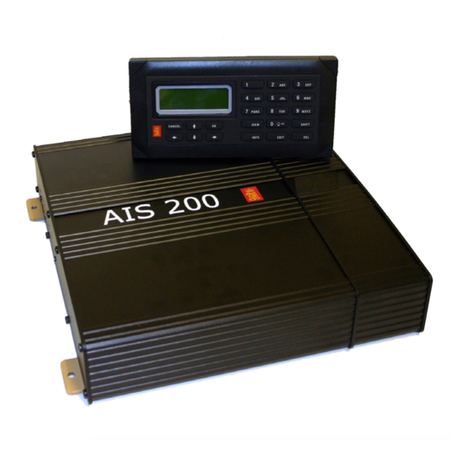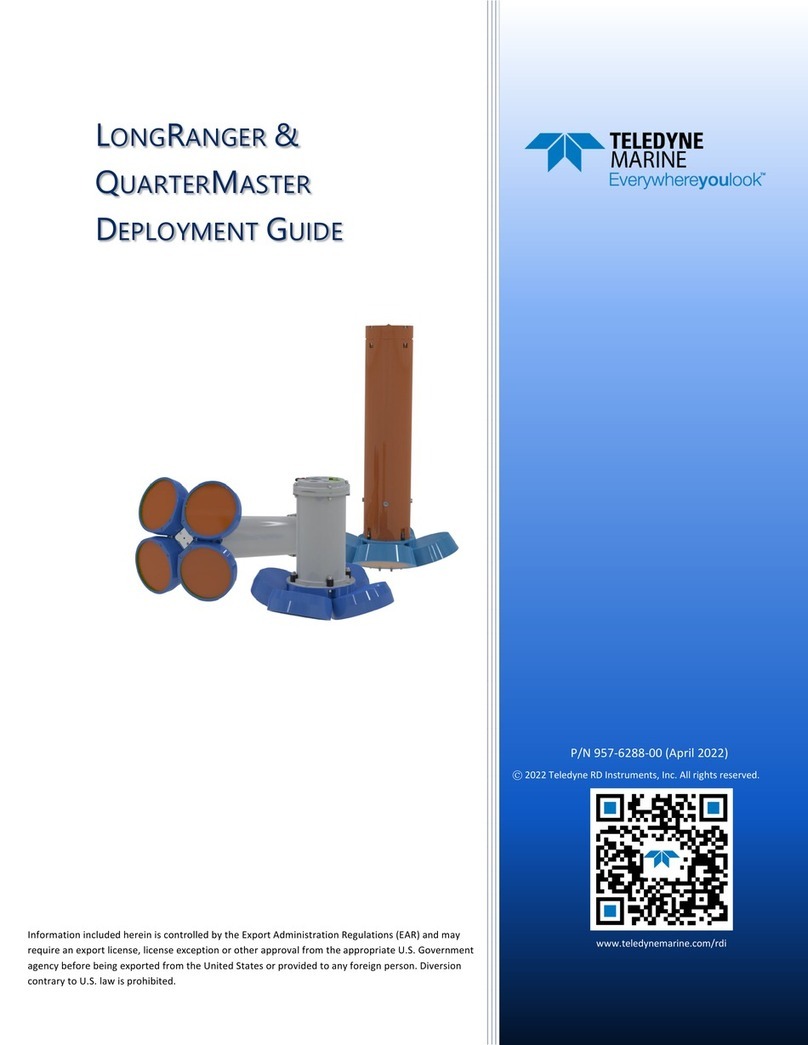ETSI ETS 300 441 User manual

*
EUROPEAN ETS 300 441
TELECOMMUNICATION February 1996
STANDARD
Source: ETSI TC-RES Reference: DE/RES-01-07
ICS: 33.060.20
Key words: Emergency, maritime, mobile, radio, receiver
Radio Equipment and Systems (RES);
Technical characteristics and methods of measurement for
maritime radiotelephone watch receivers for the distress
and calling frequency 2 182 kHz
ETSI
European Telecommunications Standards Institute
ETSI Secretariat
Postal address: F-06921 Sophia Antipolis CEDEX - FRANCE
Office address: 650 Route des Lucioles - Sophia Antipolis - Valbonne - FRANCE
Tel.: +33 92 94 42 00 - Fax: +33 93 65 47 16
Copyright Notification: No part may be reproduced except as authorized by written permission. The copyright and the
foregoing restriction extend to reproduction in all media.
© European Telecommunications Standards Institute 1996. All rights reserved.

Page 2
ETS 300 441: February 1996
Whilst every care has been taken in the preparation and publication of this document, errors in content,
typographical or otherwise, may occur. If you have comments concerning its accuracy, please write to
"ETSI Editing and Committee Support Dept." at the address shown on the title page.

Page 3
ETS 300 441: February 1996
Contents
Foreword .......................................................................................................................................................7
1 Scope..................................................................................................................................................9
2 Normative references..........................................................................................................................9
3 Abbreviations and symbols .................................................................................................................9
3.1 Abbreviations.......................................................................................................................9
3.2 Symbols...............................................................................................................................9
4 General requirements .......................................................................................................................10
4.1 Construction.......................................................................................................................10
4.1.1 Equipment elements......................................................................................10
4.1.2 Design...........................................................................................................10
4.1.3 Inspection and maintenance .........................................................................10
4.1.4 Illumination....................................................................................................10
4.1.5 Interfaces.......................................................................................................10
4.2 Controls and indicators......................................................................................................10
4.2.1 General..........................................................................................................10
4.2.2 Controls.........................................................................................................10
4.2.3 Indicators.......................................................................................................11
4.2.4 Misuse...........................................................................................................11
4.3 Labels ................................................................................................................................11
4.3.1 Power supply.................................................................................................11
4.3.2 Identification..................................................................................................11
4.3.3 Compass safe distance.................................................................................11
4.4 Safety precautions.............................................................................................................11
4.4.1 Protection......................................................................................................11
4.4.2 Earthing.........................................................................................................11
4.4.3 Antenna static protection...............................................................................11
4.4.4 Access...........................................................................................................11
4.5 Tuning................................................................................................................................11
4.6 Classes of emission...........................................................................................................12
4.7 Warming up period ............................................................................................................12
4.8 Instructions.........................................................................................................................12
4.8.1 Repair instructions.........................................................................................12
4.8.2 Accessibility...................................................................................................12
5 Test conditions, power supplies and ambient temperatures.............................................................12
5.1 General..............................................................................................................................12
5.2 Test power source.............................................................................................................12
5.3 Normal test conditions.......................................................................................................12
5.3.1 Normal temperature and humidity.................................................................12
5.3.2 Normal test power source .............................................................................13
5.3.2.1 Mains voltage and frequency...............................................13
5.3.2.2 Secondary battery power sources.......................................13
5.3.2.3 Other power sources...........................................................13
5.4 Extreme test conditions .....................................................................................................13
5.4.1 Extreme temperatures...................................................................................13
5.4.2 Extreme values of the test power source......................................................13
5.4.2.1 Mains voltage and frequency...............................................13
5.4.2.2 Secondary battery power sources.......................................13
5.4.2.3 Other power sources...........................................................13
5.5 Procedures for tests at extreme temperatures..................................................................13
5.6 Artificial antenna ................................................................................................................14
5.7 Test signals applied to the receiver input...........................................................................14
5.8 Measurement uncertainty and interpretation of the measuring results..............................14

Page 4
ETS 300 441: February 1996
5.8.1 Measurement uncertainty ............................................................................. 14
5.8.2 Interpretation of the measurement results.................................................... 14
6 Environmental tests.......................................................................................................................... 15
6.1 Introduction........................................................................................................................ 15
6.2 Procedure.......................................................................................................................... 15
6.3 Performance check........................................................................................................... 15
6.4 Vibration test ..................................................................................................................... 15
6.4.1 Method of measurement............................................................................... 15
6.4.2 Requirement................................................................................................. 16
6.5 Damp heat test.................................................................................................................. 16
6.5.1 General......................................................................................................... 16
6.5.2 Method of measurement............................................................................... 16
6.5.3 Requirement................................................................................................. 16
7 Receiver............................................................................................................................................ 16
7.1 Audio frequency output power........................................................................................... 16
7.1.1 Definition....................................................................................................... 16
7.1.2 Method of measurement............................................................................... 16
7.1.3 Limit.............................................................................................................. 16
7.2 Maximum usable sensitivity............................................................................................... 17
7.2.1 Definition....................................................................................................... 17
7.2.2 Method of measurement............................................................................... 17
7.2.3 Limit.............................................................................................................. 17
7.3 Audio frequency pass band............................................................................................... 17
7.3.1 Definition....................................................................................................... 17
7.3.2 Method of measurement............................................................................... 17
7.3.3 Limits ............................................................................................................ 17
7.4 Adjacent signal selectivity ................................................................................................. 17
7.4.1 Definition....................................................................................................... 17
7.4.2 Method of measurement............................................................................... 17
7.4.3 Limits ............................................................................................................ 18
7.5 Blocking............................................................................................................................. 18
7.5.1 Definition....................................................................................................... 18
7.5.2 Method of measurement............................................................................... 18
7.5.3 Limits ............................................................................................................ 18
7.6 Cross modulation.............................................................................................................. 18
7.6.1 Definition....................................................................................................... 18
7.6.2 Method of measurement............................................................................... 18
7.6.3 Limit.............................................................................................................. 19
7.7 Intermodulation.................................................................................................................. 19
7.7.1 Definition....................................................................................................... 19
7.7.2 Method of measurement............................................................................... 19
7.7.3 Limit.............................................................................................................. 19
7.8 Spurious response rejection ratio...................................................................................... 19
7.8.1 Definition....................................................................................................... 19
7.8.2 Method of measurement............................................................................... 19
7.8.3 Limit.............................................................................................................. 20
7.9 Harmonic distortion........................................................................................................... 20
7.9.1 Definition....................................................................................................... 20
7.9.2 Method of measurement............................................................................... 20
7.9.3 Limit.............................................................................................................. 20
7.10 Conducted spurious emissions......................................................................................... 20
7.10.1 Definition....................................................................................................... 20
7.10.2 Method of measurement............................................................................... 20
7.10.3 Limits ............................................................................................................ 20
7.11 Automatic gain control....................................................................................................... 20
7.11.1 Methods of measurement............................................................................. 21
7.11.2 Limits ............................................................................................................ 21
7.12 Audio frequency gain controls........................................................................................... 21
7.12.1 Definition....................................................................................................... 21
7.12.2 Method of measurement............................................................................... 21
7.12.3 Limit .............................................................................................................. 21

Page 5
ETS 300 441: February 1996
7.13 Protection of input circuits..................................................................................................21
7.13.1 Definition .......................................................................................................21
7.13.2 Method of measurement ...............................................................................21
7.13.3 Limit...............................................................................................................21
8 Muting device....................................................................................................................................22
8.1 General..............................................................................................................................22
8.2 Mute response...................................................................................................................22
8.2.1 Methods of measurement .............................................................................22
8.2.2 Response to the radiotelephone alarm signal...............................................22
8.2.3 Response to the navigational warning signal................................................22
8.2.4 Response to the 1 300 Hz EPIRB signal.......................................................23
8.2.5 Limit...............................................................................................................23
8.3 Protection against unwanted signals .................................................................................23
8.3.1 Method of measurement...............................................................................23
8.3.1.1 Selective calling signals on 2 170,5 kHz..............................23
8.3.1.2 Speech modulation..............................................................23
8.3.1.3 Non-specific 2 200 Hz signals .............................................23
8.3.2 Limits.............................................................................................................24
8.4 Operation during radiotelephone silence periods ..............................................................24
8.5 Provisions for testing..........................................................................................................24
History..........................................................................................................................................................25

Page 6
ETS 300 441: February 1996
Blank page

Page 7
ETS 300 441: February 1996
Foreword
This European Telecommunication Standard (ETS) has been produced by the Radio Equipment and
Systems (RES) Technical Committee of the European Telecommunications Standards Institute (ETSI).
Transposition dates
Date of adoption of this ETS: 23 February 1996
Date of latest announcement of this ETS (doa): 31 May 1996
Date of latest publication of new National Standard
or endorsement of this ETS (dop/e): 30 November 1996
Date of withdrawal of any conflicting National Standard (dow): 30 November 1996

Page 8
ETS 300 441: February 1996
Blank page

Page 9
ETS 300 441: February 1996
1 Scope
This ETS states the minimum requirements for maritime radiotelephone watch receivers, including power
supply units or converters, intended for keeping watch on the international distress and calling frequency
2 182 kHz.
This ETS is intended to cover equipment installed below deck in accordance with the requirement of the
International Maritime Organization (IMO) [2].
This ETS includes the relevant provisions of the Radio Regulations [1] and of the International Maritime
Organization [2].
2 Normative references
This ETS incorporates by dated and undated reference, provisions from other publications. These
normative references are cited at the appropriate places in the text and the publications are listed
hereafter. For dated references, subsequent amendments to or revisions of any of these publications
apply to this ETS only when incorporated in it by amendment or revision. For undated references the latest
edition of the publication referred to applies.
[1] ITU Radio Regulations.
[2] International Convention for Safety of Life at Sea, as amended 1988.
[3] ISO Recommendation 694 Method B.
[4] ETR 028: "Radio Equipment and Systems (RES); Uncertainties in the
measurement of mobile radio equipment characteristics".
[5] ITU-R Recommendation 332-4: "Selectivity of receivers".
3 Abbreviations and symbols
3.1 Abbreviations
For the purposes of this ETS, the following abbreviations apply:
AGC Automatic Gain Control
emf electromotive force
EPIRB Emergency Position-Indicating Radio Beacon
rms root mean square
IMO International Maritime Organization
SND/N Signal + Noise + Distortion/Noise
3.2 Symbols
For the purposes of this ETS, the following symbols apply:
A2A Double sideband, single channel containing quantized or digital information with
the use of a modulating sub-carrier, telegraphy.
H2A Single sideband with full carrier single channel containing quantized or digital
information with the use of a modulating sub-carrier, telegraphy.
A3E Double sideband, single channel containing analogue information, telephony.
H3E Single sideband, full carrier, single channel containing analogue information,
telephony.

Page 10
ETS 300 441: February 1996
4 General requirements
4.1 Construction
4.1.1 Equipment elements
The equipment shall comprise the following elements:
- a receiver;
- a loudspeaker;
- a filtering unit and/or a muting device to silence the loudspeaker in the absence of any of the signals
stated in clause 8;
- optionally, a device may be provided for disconnecting the filter, muting device or both during the
periods of radiotelephone silence.
4.1.2 Design
In all respects the mechanical and electrical design, construction and finish of the equipment shall
conform with good engineering practice, and the equipment shall be suitable for use on board ships at
sea.
4.1.3 Inspection and maintenance
All parts of the equipment which are subject to inspection and maintenance adjustments shall be easily
accessible. Components shall be easily identifiable, either by markings within the equipment or with the
aid of the technical description.
The equipment shall be so designed that the main units can be replaced readily, without elaborate
recalibration or readjustment.
4.1.4 Illumination
Means shall be provided for reducing, to extinction, the output of any light source on the equipment.
4.1.5 Interfaces
Connection of, or failure within, any external circuits shall not degrade the performance of the equipment.
4.2 Controls and indicators
4.2.1 General
All controls, instruments, monitoring devices and input/output points shall be clearly labelled.
All controls shall be of sufficient size to enable the usual control functions to be easily performed.
4.2.2 Controls
Only the following controls shall be provided on the exterior of the equipment:
- on/off switch;
- volume control for adjusting the audio frequency power as described in subclause 7.1;
- control for reducing the brightness of light sources, as described in subclause 4.1.4;
- muting device control or controls where clause 8 applies;
- filter control where subclause 8.4 applies;

Page 11
ETS 300 441: February 1996
- control for disabling the automatic control as described in subclause 8.4;
- a manual switch to take the mute and/or filtering unit out of operation.
4.2.3 Indicators
The status of all the controls shall be clearly indicated.
4.2.4 Misuse
The equipment shall be so designed that the misuse of the controls shall not cause damage to the
equipment or injury to personnel.
4.3 Labels
4.3.1 Power supply
Details of the power supply from which the equipment is intended to operate shall be clearly indicated on
the equipment.
4.3.2 Identification
The equipment shall be clearly marked on the exterior with identification of the manufacturer, type
designation of the equipment and serial number.
4.3.3 Compass safe distance
The compass safe distance according to ISO Recommendation 694 Method B [3] shall be declared by the
manufacturer and marked on the equipment.
4.4 Safety precautions
4.4.1 Protection
Provisions shall be made for protecting the equipment from damage if the power supply is subjected to
transient voltage changes and from damage by accidental reversal of the polarity of the power supply.
4.4.2 Earthing
Means shall be provided for earthing exposed metallic parts of the equipment, but this shall not cause any
terminal of the source of energy to be earthed.
4.4.3 Antenna static protection
In order to provide protection against damage due to static voltage which may appear at the input of the
receiver, there shall be a dc path from the antenna terminal to the chassis not exceeding 100 kΩ.
4.4.4 Access
All parts and wiring in which the direct or alternating voltages or both combine to give a peak voltage
greater than 50 V, shall be protected against accidental access and shall be isolated automatically from all
sources of electrical energy when the protective covers are removed.
Alternatively, the equipment shall be so constructed that access to such voltages may only be gained after
having used a tool for this purpose, such as a spanner or a screwdriver, and warning labels shall be
prominently displayed both within the equipment and on the protective covers.
4.5 Tuning
The receiver shall be fixed tuned on the frequency 2 182 kHz.

Page 12
ETS 300 441: February 1996
4.6 Classes of emission
The receiver shall be capable of receiving emissions of classes A2A, H2A, A3E and H3E.
4.7 Warming up period
The equipment shall meet the requirements of this ETS one minute after being switched on.
4.8 Instructions
Adequately detailed operation and maintenance instructions shall be provided with the equipment.
4.8.1 Repair instructions
If the equipment is so constructed that fault diagnosis and repair are practicable down to component level,
the instructions shall include full circuit diagrams, component layouts and component parts lists.
If the equipment contains modules in which fault diagnosis and repair down to component level is not
practicable, the instructions shall contain sufficient information to enable localisation and replacement of
the defective module(s). With regard to other modules and components in the equipment, the instructions
shall contain the information mentioned above.
4.8.2 Accessibility
All parts of the equipment which are subject to inspection and maintenance adjustments shall be easily
accessible. Components shall be easily identifiable either by markings within the equipment or with the aid
of technical description.
5 Test conditions, power supplies and ambient temperatures
5.1 General
Conformance testing shall be made under normal test conditions and also, where stated, under extreme
test conditions.
5.2 Test power source
During the conformance tests, the equipment shall be supplied from a test power source capable of
producing normal and extreme test voltages as specified in subclauses 5.3.2 and 5.4.2.
The voltage of the power source shall be measured at the input terminals of the equipment.
The test power source voltages shall be maintained within a tolerances of ±3 % relative to the voltage at
the beginning of the test.
5.3 Normal test conditions
5.3.1 Normal temperature and humidity
The normal temperature and humidity conditions for tests shall be any combination of temperature and
humidity within the following ranges:
- temperature: + 15°C to + 35°C;
- relative humidity: 20 % to 75 %.

Page 13
ETS 300 441: February 1996
5.3.2 Normal test power source
5.3.2.1 Mains voltage and frequency
The normal test voltage for equipment to be connected to the ac mains shall be the nominal ac mains
voltage. For the purpose of conformance testing, the nominal voltage shall be the declared voltage or any
of the declared voltages for which the equipment is designed.
The frequency of the test power source corresponding to the ac mains shall be 50 Hz ±1 Hz.
5.3.2.2 Secondary battery power sources
When the equipment is designed for operation from a secondary battery power source, the normal test
voltage shall be the nominal voltage of the battery (12 V, 24 V etc.).
5.3.2.3 Other power sources
When the equipment is designed for operation from other power sources, the normal test voltage shall be
stated by the equipment manufacturer.
5.4 Extreme test conditions
5.4.1 Extreme temperatures
For tests at extreme temperatures, measurements shall be made in accordance with subclause 5.5 at
- 15°C (± 3°C) and at + 55°C (± 3°C).
5.4.2 Extreme values of the test power source
5.4.2.1 Mains voltage and frequency
The extreme test voltages for equipment to be connected to the ac mains shall be the nominal mains
voltage ± 10 %. The frequency of the test power source shall be 50 Hz ± 1 Hz.
5.4.2.2 Secondary battery power sources
When the equipment is designed for operation from a secondary battery, the extreme test voltages shall
be 1,3 and 0,9 times the nominal voltage of the battery (12 V, 24 V etc.).
5.4.2.3 Other power sources
When the equipment is designed for operation from other power sources, the extreme test voltages shall
be stated by the manufacturer.
5.5 Procedures for tests at extreme temperatures
The equipment shall be placed in the test chamber at normal temperature. The maximum rate of raising
or reducing the temperature of the chamber shall be 1ºC/min. The equipment shall be switched off during
the temperature stabilising periods. The sequence of measurements shall be chosen and the humidity
content in the test chamber shall be controlled so that excessive condensation does not occur.
Before conducting tests at extreme temperatures, the equipment in the test chamber shall have reached
thermal balance and be subjected to the extreme temperature for a period of between 10 hours and
16 hours.
For tests at the lower extreme temperature, the equipment shall be switched on to standby or receive
condition for one minute before measurements are performed.
For tests at the higher extreme temperature, the equipment shall be switched on for half an hour before
measurements are performed.

Page 14
ETS 300 441: February 1996
The temperature of the chamber shall be maintained at the extreme temperatures for the whole duration
of the performance test.
At the end of the test, with the equipment still in the chamber, the chamber shall be brought to normal
temperature in not less than one hour. The equipment shall then be exposed to normal temperature and
humidity for not less than three hours or until moisture has dispersed, whichever is the longer, before the
next test is carried out. Alternatively, observing the same precautions, the equipment may be returned
directly to the conditions required for the start of the next test.
5.6 Artificial antenna
For the purpose of conformance testing, the receiver shall meet the requirements of this ETS when an
artificial antenna consisting of a resistance of 10 Ωin series with a capacitance of 250 pF is connected as
described in subclause 5.7.
This shall in no way imply that the receiver shall work only with antennas having that characteristic.
5.7 Test signals applied to the receiver input
Sources of test signals for application to the receiver input shall be connected through a network such that
the impedance presented to the receiver input is equal to that of the artificial antenna specified in
subclause 5.6. This requirement shall be met irrespective of whether one or more test signals are applied
to the receiver simultaneously. In the case of multiple test signals, steps shall be taken to prevent any
undesirable effects due to interaction between the signals in the generators or other sources.
The levels of the input signals shall be expressed in terms of the emf that exists at the output terminals of
the signal sources including the associated network.
5.8 Measurement uncertainty and interpretation of the measuring results
5.8.1 Measurement uncertainty
Table 1: Absolute measurement uncertainties
Parameter Maximum values
Audio output power ±0,5 dB
Sensitivity ±3 dB
Conducted emission ±3 dB
Two signal measurement ±4 dB
For the test methods according to this ETS the uncertainty figures are valid to a confidence level of 95 %
calculated according to the methods described in ETR 028 [4].
5.8.2 Interpretation of the measurement results
The interpretation of the results recorded in a test report for the measurements described in this ETS shall
be as follows:
- the measured value related to the corresponding limit will be used to decide whether an equipment
meets the requirements of the ETS;
- the measurement uncertainty value for the measurement of each parameter shall be included in the
test report;
- the recorded value of the measurement uncertainty shall be for each measurement equal to or
lower than the figures in table 1.

Page 15
ETS 300 441: February 1996
6 Environmental tests
6.1 Introduction
The equipment shall be capable of continuous operation under the conditions of various sea states,
vibration, humidity and change of temperature likely to be experienced in a ship in which it is installed.
6.2 Procedure
Environmental tests shall be carried out before tests of the same equipment in respect to the other
requirements of this ETS are performed.
Unless otherwise stated, the equipment shall be connected to an electrical power source only during the
periods for which it is specified that electrical tests shall be carried out.
These tests shall be done with normal test voltage.
6.3 Performance check
For the purpose of this ETS, the term performance check shall be taken to mean a check of the receiver
sensitivity:
- a class A2A signal on the frequency 2 182 kHz, modulated at 1 kHz with a modulation factor of
30 % shall be applied to the receiver input. The level of the input signal shall be adjusted so that a
SND/N ratio of 10 dB is obtained and at the same time, 500 mW of power is provided at the output.
The level of the input signal shall be measured;
- the level of the input signal shall be lower than + 20 dBµV (emf).
6.4 Vibration test
6.4.1 Method of measurement
The equipment shall be clamped to the vibration table by its normal means of support and in its normal
operating position.
Provisions may be made to reduce or nullify any adverse effect on the equipment performance which may
be caused by the presence of any electro-magnetic field due to the vibration table.
Taking at least 15 minutes to cover each octave of frequency, the equipment shall be subjected to
sinusoidal vertical vibration at all frequencies between:
- 5 Hz and 12,5 Hz with an excursion of ±1,6 mm ±10 %;
- 12,5 Hz and 25 Hz with an excursion of ±0,38 mm ±10 %;
- 25 Hz and 50 Hz with an excursion of ±0,10 mm ±10 %.
A resonance search shall be carried out during the vibration test. If resonance of any part of any
component is observed, the equipment shall be subjected to vibration endurance test at each resonance
frequency with the duration of not less than two hours at the vibration level specified above.
The test shall be repeated with vibration in each of the mutual perpendicular direction in the horizontal
plane.
A performance check shall be carried out during the test.
After conducting the vibration tests, the equipment shall be inspected for any mechanical deterioration.

Page 16
ETS 300 441: February 1996
6.4.2 Requirement
The limit of the performance check shall be met.
There shall be no harmful deterioration of the equipment visible to the naked eye.
6.5 Damp heat test
6.5.1 General
The maximum rate of raising or reducing the temperature of the chamber in which the equipment is being
tested shall be 10°C/min.
6.5.2 Method of measurement
The equipment shall be placed in a chamber at normal room temperature and humidity which, steadily,
over a period of three hours (± 30 minutes), shall be heated from room temperature to + 40°C (± 3°C) and
shall during this period be brought to a relative humidity of 93 % (± 2 %) so that excessive condensation is
avoided.
These conditions shall be maintained for a period of at least 10 hours.
After this period, any climatic control devices provided within the equipment may be switched on.
30 minutes later the equipment shall be switched on, and shall then be kept working continuously for a
period of two hours.
The equipment shall be subjected to a performance check during the two hour period.
The temperature and the relative humidity of the chamber shall be maintained at + 40°C (± 3°C) and 93 %
(± 2 %) during the 2 hours and 30 minutes period.
At the end of the test, and with the equipment still in the chamber, the chamber shall be brought to room
temperature in not less than one hour. The equipment shall then be exposed to normal room temperature
and humidity for not less than three hours, or until moisture has dispersed, which ever is longer, before
the next test is carried out.
6.5.3 Requirement
The limit of the performance check shall be met.
7 Receiver
7.1 Audio frequency output power
7.1.1 Definition
The audio frequency output power of the receiver is the available power in the loudspeaker.
7.1.2 Method of measurement
The standard output power of the receiver shall be measured at a frequency of 1 kHz in a resistance
equal to the modulus of the impedance of the loudspeaker.
7.1.3 Limit
The standard output power used in this ETS shall be 50 mW.
The rated output power stated by the manufacturer shall be at least 500 mW.

Page 17
ETS 300 441: February 1996
7.2 Maximum usable sensitivity
7.2.1 Definition
The maximum usable sensitivity is the minimum level of a radio frequency signal with specified
modulation, which produces at the receiver output a chosen value of the signal-noise-distortion to noise
(SND/N) ratio and, at the same time, an output power at least equal to a specified value.
7.2.2 Method of measurement
A class A2A signal on the frequency 2 182 kHz, modulated at 1 kHz with a modulation factor of 30 % shall
be applied to the receiver input. The level of the input signal shall be adjusted so that a SND/N ratio of
10 dB is obtained and at the same time, 500 mW of power is provided at the output. The level of the input
signal shall be measured.
Measurements shall be made under normal and extreme test conditions (subclauses 5.4.1 and 5.4.2
applied simultaneously).
7.2.3 Limit
The maximum usable sensitivity shall be better than + 20 dBµV (emf).
7.3 Audio frequency pass band
7.3.1 Definition
The audio frequency pass band is the frequency band at the output of the receiver within which the
attenuation relative to the maximum level does not exceed 6 dB.
7.3.2 Method of measurement
An A2A signal with a level of + 60 dBµV, modulated to a depth of 30 % at 1 kHz shall be applied to the
receiver input and the receiver shall be adjusted to give standard output power. The modulation frequency
shall then be varied from 10 Hz to 10 kHz, maintaining a constant modulation depth of 30 % and the
output level corresponding to each modulation frequency shall be measured at a sufficient number of
points to enable the audio frequency pass band to be determined.
7.3.3 Limits
The audio frequency pass band shall be at least 350 Hz to 2,7 kHz.
The attenuation relative to the peak response shall be at least 20 dB at 6 kHz.
7.4 Adjacent signal selectivity
7.4.1 Definition
The adjacent signal selectivity of the receiver is the ability to discriminate between a wanted signal to
which the receiver is tuned and unwanted signals simultaneously in channels adjacent to that of the
wanted signal. For the purpose of this ETS, the adjacent signal selectivity is defined as the ratio of the
signal levels at the receiver input which results in a reduction in the SND/N ratio from 20 dB to 14 dB.
7.4.2 Method of measurement
The arrangements for applying two test signals to the receiver input, shall be according to subclause 5.7.
The automatic gain control of the equipment shall be in operation. The wanted test signal shall be an A2A
signal at 2 182 kHz, modulated to a depth of 30 % at 1 kHz.
The receiver shall be adjusted to give standard output power at a SND/N ratio of 20 dB.

Page 18
ETS 300 441: February 1996
An unwanted A2A signal at a frequency shown in table 2, modulated to a depth of 30 % at 400 Hz, shall
additionally be applied to the receiver input. Starting from a low level, this signal shall be increased until
the SND/N ratio is decreased from 20 dB to 14 dB.
7.4.3 Limits
The adjacent signal selectivity shall not be less than the values given in table 2.
Table 2: Adjacent channel selectivity limits
Frequency of unwanted
signal relative to 2 182 kHz Adjacent signal selectivity
- 10 kHz and + 10 kHz 40 dB
- 20 kHz and + 20 kHz 50 dB
7.5 Blocking
7.5.1 Definition
Blocking is a change (generally a reduction) in the wanted output power of a receiver or a reduction in the
SND/N ratio, due to an unwanted signal on another frequency.
7.5.2 Method of measurement
The test shall be carried out with the automatic gain control operative. The measurement shall be made
by means of the simultaneous application of two test signals to the input of the receiver. One of the test
signals is the wanted signal to which the receiver is tuned and the other is the unwanted signal.
The wanted signal shall be an A2A signal with a carrier frequency of 2 182 kHz, modulated to a depth of
30 % at 1 kHz.
Measurements shall be carried out with an input level of the wanted signal of + 60 dBµV and repeated with
a level equal to the maximum usable sensitivity of the receiver as measured in subclause 7.2.
The receiver shall be adjusted so that the wanted signal gives standard output power (subclause 7.1).
The unwanted signal shall be unmodulated and shall have a frequency of ±20 kHz relative to that of the
wanted signal.
The input level of the unwanted signal shall be adjusted until either it causes a change of 3 dB in the
output level of the wanted signal or until it causes a reduction in the SND/N ratio of 6 dB, whichever
occurs first. The input level of the unwanted signal when the specified condition is reached, shall be taken
as the blocking level.
7.5.3 Limits
With the wanted signal at + 60 dBµV, the blocking level shall not be less than 100 dBµV.
With the wanted signal at the measured maximum usable sensitivity level, the blocking level shall be at
least + 65 dB above the measured usable sensitivity.
7.6 Cross modulation
7.6.1 Definition
Cross modulation is the transfer of modulation from an unwanted, modulated signal on an another
frequency to the wanted signal.

Page 19
ETS 300 441: February 1996
7.6.2 Method of measurement
The test shall be carried out with the automatic gain control operative. The measurement shall be made
by means of the simultaneous application of two test signals to the input of the receiver. One of the test
signals is the wanted signal to which the receiver is tuned and the other is the unwanted signal.
The wanted signal shall be an A2A signal with a carrier frequency of 2 182 kHz, modulated to a depth of
30 % at 1 kHz.
Measurements shall be carried out with an input level of the wanted signal of + 60 dBµV.
The receiver shall be adjusted so that the wanted signal gives standard output power (subclause 7.1). The
modulation of the wanted signal shall be switched off.
The unwanted signal shall have a frequency of ±20 kHz relative to that of the wanted signal and be
modulated to a depth of 30 % at 400 Hz. The input level of the unwanted signal shall be increased until
total unwanted power in the receiver output due to cross modulation is 30 dB below the standard output
power.
The input of the unwanted signal at which this condition is reached is the cross modulation level.
7.6.3 Limit
The cross modulation level shall not be less than + 90 dBµV.
7.7 Intermodulation
7.7.1 Definition
Intermodulation is a process by which signals are produced from two or more (generally unwanted)
signals simultaneously present in a non-linear circuit.
7.7.2 Method of measurement
With the automatic gain control operative, an A2A test signal at the carrier frequency 2 182 kHz
modulated to a depth of 30 % at 1 kHz shall be applied to the receiver input at a level of + 30 dBµV, and
the audio frequency gain control shall be adjusted to give standard output power. The audio frequency
gain control shall not be adjusted during the remainder of this test. The wanted signal shall then be
removed and the two unwanted signals shall be simultaneously applied to the input of the receiver. The
signal nearest to the wanted signal frequency shall be unmodulated. The other unwanted signal shall be
an A2A signal modulated to a depth of 30 % at 1 kHz.
Neither of the two signals shall have a frequency within 30 kHz from the wanted signal (input frequencies
likely to cause unwanted inter-modulation products are mentioned in ITU-R Recommendation 332-4,
section 6.4 [5]). When choosing the frequencies used for this measurement, care should be taken to avoid
frequencies at which spurious responses occur. The input levels of the two interfering signals shall remain
equal and shall be adjusted until the output power of the receiver due to the interfering signals is equal to
the standard output power.
7.7.3 Limit
The level of either of the two interfering signals which results in standard output power shall not be less
than + 80 dBµV.
7.8 Spurious response rejection ratio
7.8.1 Definition
The spurious response rejection ratio is the ratio of the input level of an unwanted signal at the frequency
of the spurious response, to the input level of a wanted signal, when the wanted and unwanted signals
individually produce the same SND/N ratio at the receiver output.

Page 20
ETS 300 441: February 1996
7.8.2 Method of measurement
An A2A test signal at the carrier frequency 2 182 kHz, modulated to a depth of 30 % at 1 kHz shall be
applied to the receiver input at a level such that a SND/N ratio of 10 dB is produced.
The carrier frequency of the input signal shall then be varied between 100 kHz and 2 GHz to search for
spurious responses. For each spurious response found, the carrier frequency of the input signal shall be
adjusted to give maximum output power. The input level shall then be adjusted to give a SND/N ratio of
10 dB at the output of the receiver. The ratio between the input level of each spurious signal and the input
level of the wanted signal shall then be evaluated.
7.8.3 Limit
All spurious response rejection ratios shall be not less than 60 dB.
7.9 Harmonic distortion
7.9.1 Definition
The harmonic distortion at the output of the receiver is defined as the percentage of the total rms voltage
of all harmonic components of the modulating audio frequency to the total rms voltage of the signal
delivered by the receiver.
7.9.2 Method of measurement
An A2A test signal at the carrier frequency 2 182 kHz modulated to a depth of 30 % at 1 kHz shall be
applied to the receiver input and its level shall be set in turn to + 40 dBµV and + 80 dBµV. The audio
frequency gain control shall be set to give rated output power. At each setting of input level the modulation
depth shall be increased from 30 % to 80 % and the audio gain control used to maintain the output level at
rated output power.
7.9.3 Limit
At a modulation depth of 30 % the harmonic distortion shall not exceed 10 %.
At a modulation depth of 80 % the harmonic distortion shall not exceed 15 %.
7.10 Conducted spurious emissions
7.10.1 Definition
Conducted spurious emissions are emissions at any frequency conducted into the antenna or artificial
antenna.
7.10.2 Method of measurement
Conducted spurious emissions shall be measured across the resistive part of the artificial antenna
specified in subclause 5.6.
The measurement shall be carried out within the frequency range 9 kHz - 2 GHz using a spectrum
analyzer or a frequency selective measuring instrument. The resolution bandwidth of the spectrum
analyzer or the frequency selective measuring instrument shall be set to 200 Hz for the frequency range
9 kHz to 150 kHz, 10 kHz for the frequency range 150 kHz to 30 MHz and 100 kHz for the frequency
range 30 MHz to 2 GHz.
7.10.3 Limits
The power of any discrete component measured in the artificial antenna shall not exceed 2 nW.
7.11 Automatic gain control
An automatic gain control capable of satisfactory operation shall be provided.
Table of contents
Other ETSI Marine Equipment manuals
